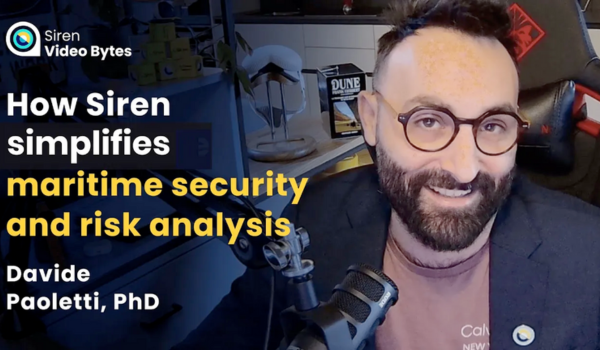How Siren simplifies maritime security and risk analysis
Summary
Maritime security has become increasingly complex in today’s global shipping environment, with thousands of vessels navigating critical waterways and sensitive areas containing valuable infrastructure. Organizations responsible for protecting underwater cables, ports, and coastal facilities face the monumental challenge of monitoring vessel movements and identifying potential security threats. Traditional methods of manually tracking and analyzing vessel data across multiple sources prove insufficient for comprehensive maritime security operations.
Problem
The maritime industry generates enormous volumes of data, with Siren’s platform tracking approximately 100,000 vessels across 26 million vessel positions through various sources including AIS (Automatic Identification System) monitoring. Manually filtering through this data, checking individual vessel positions, and cross-referencing information from multiple sources creates an overwhelming and time-consuming process for security analysts. Coast guard interventions and asset protection decisions require immediate access to comprehensive vessel intelligence, but traditional approaches fail to deliver timely, actionable insights about potential threats to critical maritime infrastructure.
Solution Implementation
Siren developed a comprehensive maritime security platform that integrates multiple data sources and provides automated risk analysis through the Siren Vessel Risk Panel. The solution allows security teams to create geo-filters around sensitive areas such as underwater cables and ports, automatically identifying potentially dangerous vessels operating in those zones. Users can simply press “calculate risk” to receive immediate intelligence on vessels of concern, with the system cross-referencing data from external vendors and internal sources to generate comprehensive risk assessments.
“We have multiple external vendors that provide us information around specific vessel and we cross reference this data with our internal sources.”
Results
Automated Risk Detection: The system transforms manual vessel tracking into intelligent threat identification, automatically calculating risk percentages (such as 80% risk levels) for potentially dangerous vessels operating near critical infrastructure like underwater cables and ports.
Real-Time Intelligence: Security teams can instantly visualize vessel movements, track GPS disabled locations that may indicate suspicious activity, and analyze encounter patterns with other vessels, providing immediate situational awareness for maritime security operations.
Comprehensive Vessel Profiling: The platform enables detailed investigation of vessel histories, including all ports visited, encounters with other ships, and periods of GPS deactivation, giving security analysts complete intelligence profiles needed for informed decision-making.
Enhanced Asset Protection: Coast guard interventions and asset protection decisions are now supported by comprehensive data analysis, allowing security teams to proactively identify and respond to threats before they reach critical maritime infrastructure.
Conclusions
Siren successfully addresses the critical challenge of maritime security through smart automation and AI-powered analysis, eliminating the need for manual vessel tracking and cross-referencing. The platform’s ability to process vast amounts of maritime data and deliver actionable intelligence represents a significant advancement in protecting critical infrastructure and coastal assets. By combining multiple data sources with intuitive visualization tools, Siren empowers security organizations to proactively identify and respond to maritime threats with unprecedented speed and accuracy.



